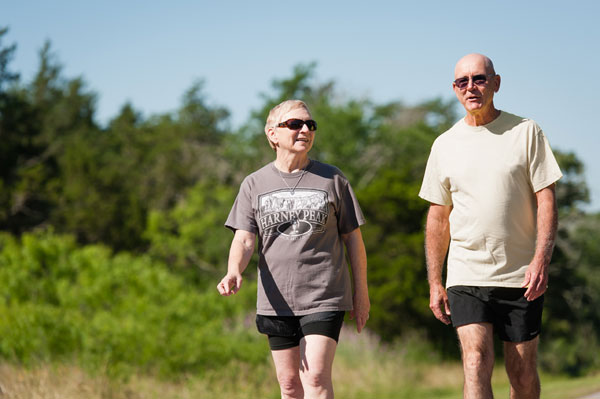Fitting in Exercise: 4 tips for being active as you age

There is no doubt that exercise is beneficial and a preventative measure for a large number of ailments, but it is especially important for older adults. Not only can regular physical activity help manage diseases such as heart disease, diabetes and cancer, and thereby reduce medical costs, but it can also help older adults maintain their physical independence.
“The benefits [of exercise] extend to old age where exercise can help older adults better manage their chronic conditions, reduce their risk of falling, and also improve mood and quality of life,” says Marcia Ory, Ph.D., M.P.H., Regents and Distinguished Professor at the Texas A&M Health Science Center School of Public Health. Ory is an expert in chronic disease management and is the Director of the Program on Healthy Aging at the Texas A&M School of Public Health.
A physically active lifestyle is more conducive to promoting a long and healthy life than a sedentary lifestyle. At all ages, it is important to get in appropriate level of exercise in order to lead a healthier life. According to The Surgeon General, most American adults should strive to achieve at least 150 minutes of moderate-intensity exercise each week.
Ory offers some tips to consider when leading an active lifestyle as you age:
1. Assess your level of ability
Before beginning an exercise, assess what your physical limits may be. “What gets older adults in trouble is trying to do too much, too fast. It is important to assess one’s current level of activity and to gradually increase the duration and intensity of effort,” says Ory.
It’s important not to push your limits. Regular physical activity holds many benefits, and increases your quality of life, but an injury can certainly set you back. Ory advises, “Exercise related injuries (e.g., soreness, strains or muscular injuries) can occur when a middle aged or older person who is mostly sedentary decides to go out and engage in vigorous activity—such as playing a game of basketball or football.”
Unless you are in peak-athletic conditions, try not to gravitate towards arduous workouts. Cardio-intense activity is not the only form of exercise that promotes fitness. More moderate levels of exercise or activity are perfectly acceptable. Gardening, walking and swimming, are all examples of more moderate forms of exercise that still keep you healthy.
The purpose of exercise is to strengthen your body, so be sure to take care of yourself and make accommodations where necessary.
2. Be holistic in your approach
In order to promote health and increased functionality, Ory suggests that exercise for older adults should be comprehensive and focus on endurance, strength, balance and flexibility.
When deciding what activities to pursue, try to incorporate different aspects of exercise. For example, brisk walking can help maintain balance and work on endurance. Other activities, such as tai-chi and yoga target strength, balance and flexibility. Another approach to achieving well-balanced fitness is to simply stagger your activities. On certain days of the week you could work on endurance training, such as walking or stair climbing, and on other days you can focus on strength training with light weights or elastic bands.
Targeting all of these elements is important to maintaining an active lifestyle. For the best benefits, a balanced approach to physical activity is recommended.
3. Enjoy what you do
“The best exercise is often the one that a person enjoys doing—and can do with minimal hassle,” says Ory. If exercise feels less like a chore and more like a hobby, you will be more likely to do it on a regular basis.
Change up your routine from time to time to make it enjoyable. For example, “Walking is one of the best exercises a person can do—and what most older persons in fact do. And this can be accomplished by walking with a family member, friend or neighbor—or the dog,” Ory states.
It is important to remember that physical activity doesn’t have to constitute a trip to the gym. It can be something you have fun with, such as gardening or swimming. No matter how you choose to be physically active, have fun with it.
4. Stay active
After assessing your level of ability and deciding what kinds of activities you enjoy, stick with it.
Maintaining your physical activity is crucial to staying in shape. Activity in bursts is certainly better than no activity, but it is not as beneficial as regular physical activity.
Taking advantage of community classes can be a great way to stay motivated. Many retirement communities and senior centers are beginning to implement classes for their members. These classes could include activities such as yoga, tai-chi, or Fit and Strong, which encourage regular physical activity in a participatory setting. Some of these classes are only available for a specified amount of time, but, according to Ory, they typically incorporate a behavioral component to help older adults stay motivated after the program expires.
Classes such as these can typically be found at local community centers or increasing at parks and recreation facilities. Overall, community classes are a great way to facilitate regular physical activity in a welcoming environment.
For more information and suggestions for leading an active life, please visit The National Institute on Aging and learn about their Go4Life campaign.
Story contributed by Elizabeth Grimm
Media contact: media@tamu.edu


